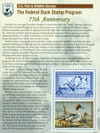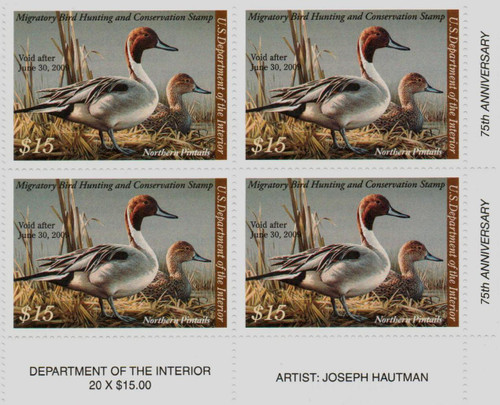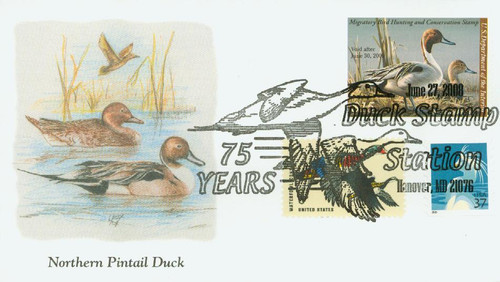
# RW75th - 2008 Federal Duck 75th Anniversary
Neat Mint Sheet Chronicles History of Federal Duck Stamps
Issued in 2008, this fun sheet tells the story of how the popular Duck Stamps were started.
Appointed Chief of the national Biological Survey by President Franklin D. Roosevelt, J.N. "Ding" Darling witness the plight of America's wetlands and made it his personal mission to protect the waterfowl that lived there. He was a driving force behind the passage of the Migratory Bird Hunting Stamp Act, which would raise fund to protect these birds and their habitat.
Darling designed the very first stamp, which has been slightly modified and reproduced on this stamp sheet. The sheet also features the 2008-09 duck stamp as well as a portrait of Darling in the selvage.
Add all this neat duck stamp history to your collection – order today.
Migratory Bird Hunting Stamp Act
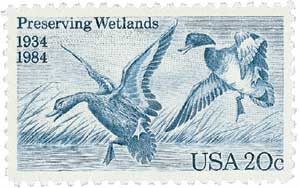
On March 16, 1934, President Franklin Roosevelt signed the Migratory Bird Hunting Stamp Act, creating America’s popular Duck Stamps.
Overhunting and a severe drought led to a rapid decrease in migratory birds in the early 1900s. The loss of nesting grounds in the north, resting areas along the migratory path, and wintering places in the south all contributed to the decline in the migratory bird population.
President Herbert Hoover signed the Migratory Bird Conservation Act in 1929. This created a commission to evaluate the establishment of new waterfowl refuges, but didn’t grant funds to buy and preserve these wetlands.
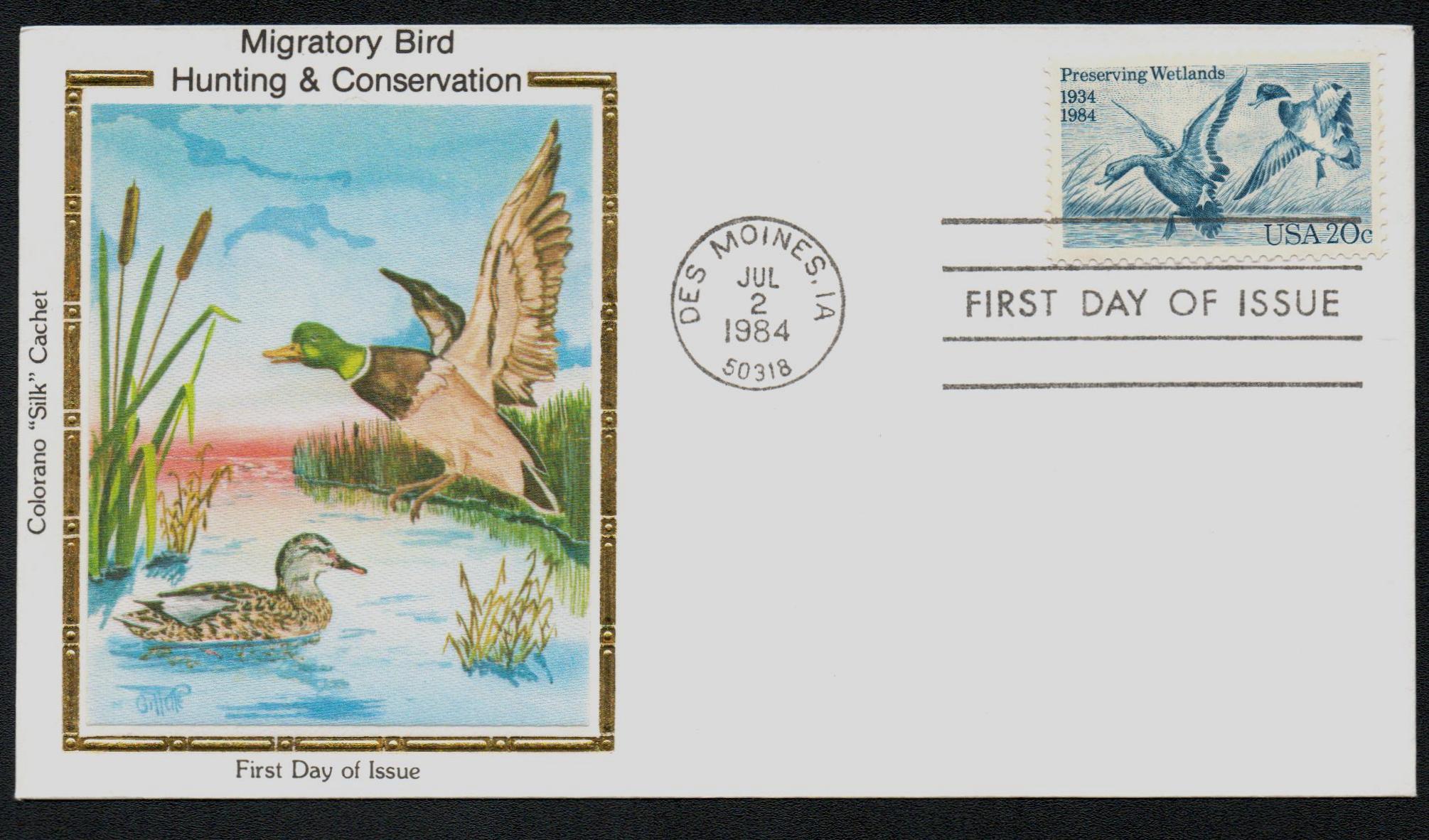
Famous cartoonist and conservationist Jay N. Darling soon grew concerned over the decreased bird habitats and potential extinction of several species. He began to incorporate the ideas of wildlife conservation into some of his cartoons. He soon gained attention for the cause and was made chief of the Biological Service – a forerunner to the Fish and Wildlife Service. In this role, he developed the idea of issuing Duck Stamps to raise money for the purchase of wetlands.
Darling then petitioned Congress to create legislation authorizing the creation of these stamps to fund waterfowl protection. As a result, they pass the Migratory Bird Hunting Stamp Act, which President Franklin Roosevelt signed into law on March 16, 1934.
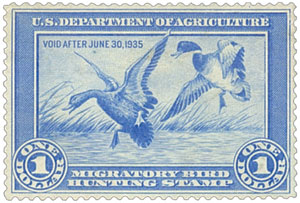
The act authorized the issuance of an annual stamp, which outdoorsmen age 16 and up were required to have in order to hunt migratory birds. The funds raised by the sale of these “Duck” stamps were then placed in the Migratory Bird Conservation Fund.
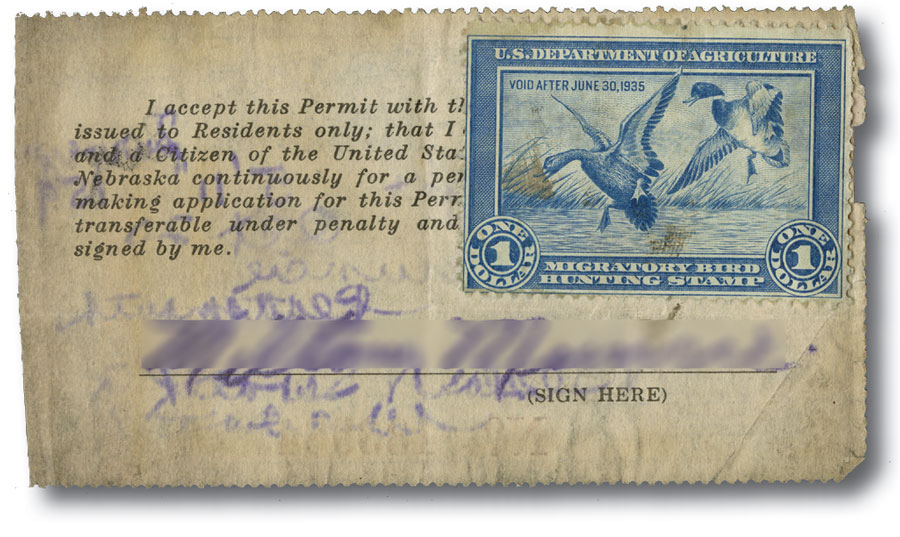
As an artist and driving force behind their creation, Darling took it upon himself to create the first design – a $1.00 stamp that pictured two mallards preparing to land. The stamp went into was issued on July 1, 1934. That first year alone, sales of the stamp raised $635,000 for wetland conservation.
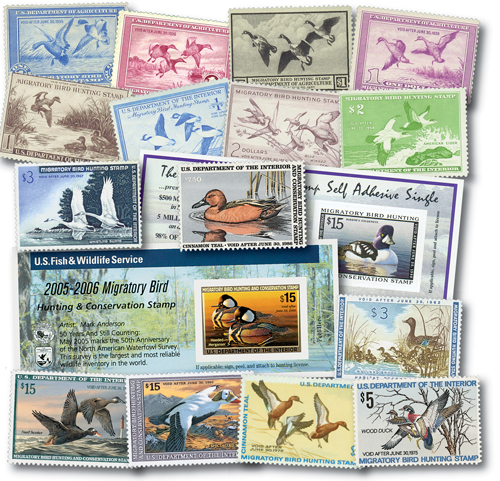
The beauty and novelty of this new stamp immediately appealed to stamp collectors, and the desire to own one became widespread. The government was unyielding, however. The stamp was for hunters only, not for collectors. It had to be attached to a license, signed, and kept intact for one year. But the collectors would not give up, and fifteen days before the first stamps expired, they were placed on sale for stamp enthusiasts.
For the next several years, the artwork for Duck Stamps was commissioned. But that changed in 1949 when designer Bob Hines (creator of the 1946-47 issue) suggested the idea for a contest, which has proven quite popular.
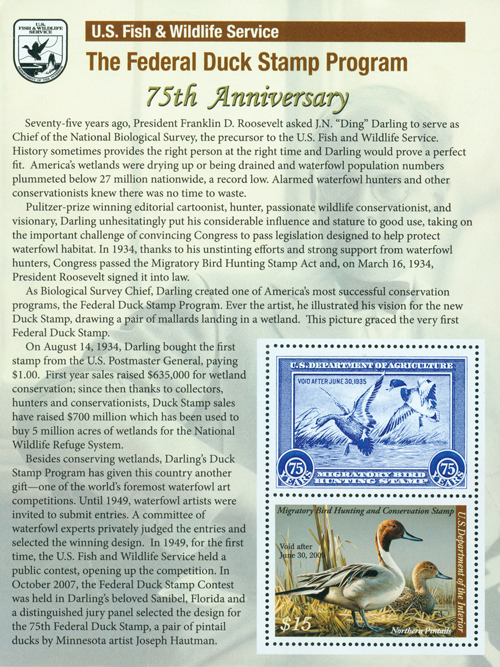
When originally purchased, ninety-eight cents of each dollar spent on the license went to wetland conservation. Since the program’s start, nearly $1 billion has been used to purchase or lease almost 6 million acres of waterfowl habitat. This land is now protected through the US Fish and Wildlife Service’s National Wildlife Refuge System. These areas benefit migrating waterfowl such as geese and ducks, but mammals, fish, reptiles, and amphibians living in the wetlands also flourish because of this program.
Bird hunters are not the only ones who purchase Duck Stamps. Bird watchers and other nature lovers gain free annual admission to the refuges when they buy a stamp from a sporting goods store or a post office. Conservationists know that a large portion of the purchase price goes to investing in America’s wetlands. Collectors buy these stamps because of the high-quality artwork pictured.
Click here to read the act and related laws.
Click here for more Duck stamps.
Neat Mint Sheet Chronicles History of Federal Duck Stamps
Issued in 2008, this fun sheet tells the story of how the popular Duck Stamps were started.
Appointed Chief of the national Biological Survey by President Franklin D. Roosevelt, J.N. "Ding" Darling witness the plight of America's wetlands and made it his personal mission to protect the waterfowl that lived there. He was a driving force behind the passage of the Migratory Bird Hunting Stamp Act, which would raise fund to protect these birds and their habitat.
Darling designed the very first stamp, which has been slightly modified and reproduced on this stamp sheet. The sheet also features the 2008-09 duck stamp as well as a portrait of Darling in the selvage.
Add all this neat duck stamp history to your collection – order today.
Migratory Bird Hunting Stamp Act

On March 16, 1934, President Franklin Roosevelt signed the Migratory Bird Hunting Stamp Act, creating America’s popular Duck Stamps.
Overhunting and a severe drought led to a rapid decrease in migratory birds in the early 1900s. The loss of nesting grounds in the north, resting areas along the migratory path, and wintering places in the south all contributed to the decline in the migratory bird population.
President Herbert Hoover signed the Migratory Bird Conservation Act in 1929. This created a commission to evaluate the establishment of new waterfowl refuges, but didn’t grant funds to buy and preserve these wetlands.

Famous cartoonist and conservationist Jay N. Darling soon grew concerned over the decreased bird habitats and potential extinction of several species. He began to incorporate the ideas of wildlife conservation into some of his cartoons. He soon gained attention for the cause and was made chief of the Biological Service – a forerunner to the Fish and Wildlife Service. In this role, he developed the idea of issuing Duck Stamps to raise money for the purchase of wetlands.
Darling then petitioned Congress to create legislation authorizing the creation of these stamps to fund waterfowl protection. As a result, they pass the Migratory Bird Hunting Stamp Act, which President Franklin Roosevelt signed into law on March 16, 1934.

The act authorized the issuance of an annual stamp, which outdoorsmen age 16 and up were required to have in order to hunt migratory birds. The funds raised by the sale of these “Duck” stamps were then placed in the Migratory Bird Conservation Fund.

As an artist and driving force behind their creation, Darling took it upon himself to create the first design – a $1.00 stamp that pictured two mallards preparing to land. The stamp went into was issued on July 1, 1934. That first year alone, sales of the stamp raised $635,000 for wetland conservation.

The beauty and novelty of this new stamp immediately appealed to stamp collectors, and the desire to own one became widespread. The government was unyielding, however. The stamp was for hunters only, not for collectors. It had to be attached to a license, signed, and kept intact for one year. But the collectors would not give up, and fifteen days before the first stamps expired, they were placed on sale for stamp enthusiasts.
For the next several years, the artwork for Duck Stamps was commissioned. But that changed in 1949 when designer Bob Hines (creator of the 1946-47 issue) suggested the idea for a contest, which has proven quite popular.

When originally purchased, ninety-eight cents of each dollar spent on the license went to wetland conservation. Since the program’s start, nearly $1 billion has been used to purchase or lease almost 6 million acres of waterfowl habitat. This land is now protected through the US Fish and Wildlife Service’s National Wildlife Refuge System. These areas benefit migrating waterfowl such as geese and ducks, but mammals, fish, reptiles, and amphibians living in the wetlands also flourish because of this program.
Bird hunters are not the only ones who purchase Duck Stamps. Bird watchers and other nature lovers gain free annual admission to the refuges when they buy a stamp from a sporting goods store or a post office. Conservationists know that a large portion of the purchase price goes to investing in America’s wetlands. Collectors buy these stamps because of the high-quality artwork pictured.
Click here to read the act and related laws.
Click here for more Duck stamps.



